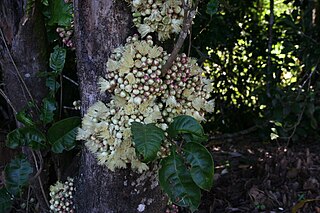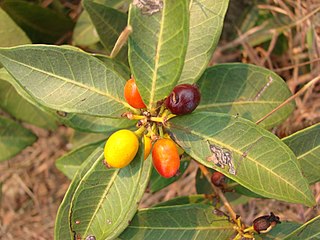
A forest is an area of land dominated by trees. Hundreds of definitions of forest are used throughout the world, incorporating factors such as tree density, tree height, land use, legal standing, and ecological function. The United Nations' Food and Agriculture Organization (FAO) defines a forest as, "Land spanning more than 0.5 hectares with trees higher than 5 meters and a canopy cover of more than 10 percent, or trees able to reach these thresholds in situ. It does not include land that is predominantly under agricultural or urban use." Using this definition, Global Forest Resources Assessment 2020 found that forests covered 4.06 billion hectares, or approximately 31 percent of the world's land area in 2020.

Grasslands are areas where the vegetation is dominated by grasses (Poaceae). However, sedge (Cyperaceae) and rush (Juncaceae) can also be found along with variable proportions of legumes, like clover, and other herbs. Grasslands occur naturally on all continents except Antarctica and are found in most ecoregions of the Earth. Furthermore, grasslands are one of the largest biomes on earth and dominate the landscape worldwide. There are different types of grasslands: natural grasslands, semi-natural grasslands, and agricultural grasslands. They cover 31–43% of the Earth's land area.

A savanna or savannah is a mixed woodland-grassland ecosystem characterised by the trees being sufficiently widely spaced so that the canopy does not close. The open canopy allows sufficient light to reach the ground to support an unbroken herbaceous layer consisting primarily of grasses.

Tropical climate is one of the five major climate groups in the Köppen climate classification. Tropical climates are characterized by monthly average temperatures of 18 ℃ (64.4 ℉) or higher year-round and feature hot temperatures. Annual precipitation is often abundant in tropical climates, and shows a seasonal rhythm to varying degrees. There are normally only two seasons in tropical climates, a wet (rainy) season and a dry season. The annual temperature range in tropical climates is normally very small. Sunlight is intense.

Eugenia is a genus of flowering plants in the myrtle family Myrtaceae. It has a worldwide, although highly uneven, distribution in tropical and subtropical regions. The bulk of the approximately 1,100 species occur in the New World tropics, especially in the northern Andes, the Caribbean, and the Atlantic Forest of eastern Brazil. Other centers of diversity include New Caledonia and Madagascar. Many of the species that occur in the Old World have received a new classification into the genus Syzygium.

An oak savanna is a type of savanna-or lightly forested grassland- where oaks are the dominant trees, the term oakery or woodlands is also used commonly, though the former is more prevalent when referencing the Mediterranean area. These savannas were maintained historically through wildfires set by lightning, humans, grazing, low precipitation, and/or poor soil.

Eugenia uniflora, the pitanga, Suriname cherry, Brazilian cherry, Cayenne cherry, cerisier carré, monkimonki kersie or ñangapirí, is a flowering plant in the family Myrtaceae, native to tropical South America’s east coast, ranging from Suriname, French Guiana to southern Brazil, as well as Uruguay and parts of Paraguay and Argentina. It is often used in gardens as a hedge or screen. The tree was introduced to Bermuda for ornamental purposes but is now out of control and listed as an invasive species. The tree has also been introduced to Florida.

The University of Wisconsin–Madison Arboretum is a teaching and research facility of the University of Wisconsin–Madison and the site of historic research in ecological restoration. In addition to its 1,260 acres (5 km2) in Madison, Wisconsin, the Arboretum also manages 520 acres (210 ha) of remnant forests and prairies throughout Wisconsin. It was designated a National Historic Landmark in 2021, in recognition for its role as a pioneer in the field of ecological restoration.

Bemarivo Reserve is a wildlife reserve in the north-west of Madagascar. It was created in 1956 and covers an area of 12,080 hectares. The reserve is known for its fauna especially endemic birds.
Pitanga, Paraná is a municipality in the state of Paraná in the Southern Region of Brazil.

Syzygium cormiflorum, commonly known as the bumpy satinash, is a species of Syzygium tree endemic to Queensland in northeastern Australia.

Antônio Luiz Sampaio, better known by his stage name Antônio Pitanga, is a Brazilian actor. He became internationally known for playing several roles on films of the Cinema Novo movement in the 1960s.

I'd Receive the Worst News from Your Beautiful Lips is a 2011 Brazilian romance drama film directed by Beto Brant and Renato Ciasca. Based on a novel of the same name by Marçal Aquino, it stars Camila Pitanga, Gustavo Machado, and Zecarlos Machado, in a love triangle.
A geoxyle is a plant in which an enlarged, woody structure occurs beneath the surface of the ground. Such plants have developed independently in various plant lineages, mostly evolving in the Pliocene and subsequently diverging within the last two million years. In contrast to their close relatives, these plants have developed in areas with both high rainfall and a high frequency of fires. They are sometimes known as underground trees, and the areas where they grow as underground forests.
Babilônia is a Brazillan primetime telenovela produced and broadcast by Rede Globo. It premiered on March 16, 2015, replacing Império at 9:10 p.m. / 10:25 p.m. (BRT/AMT).
Eugenia subterminalis, commonly known as cambuí pitanga, cereja do mato verdadeira, pitanga lisa de sombra, pitanga preta, and cambuízão vermelho do rio Paranapanema, is a species of plant in the family Myrtaceae. It is endemic to araucária forest in Bolivia, northern Brazil, Colombia, Ecuador, and Peru. The plant is a semi-deciduous shrub that grows to between 2 and 4 metres tall, and produces egg shaped fruit between 15 and 25mm tall, and 18 to 20mm wide.

Eugenia calycina, also known as savannah cherry, field cherry, Jabuti cherry, Grao de galo, cerejinha, cereja de cerrado, pitanga-vermelha, red pitanga, pitanga cherry of cerrado, and ca-ajaboti, is a flowering shrub in the family Myrtaceae.













